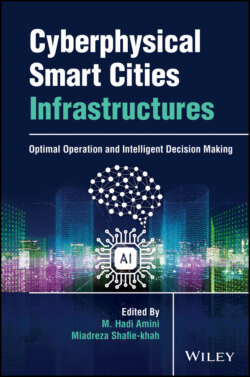Читать книгу Cyberphysical Smart Cities Infrastructures - Группа авторов - Страница 13
1.3 AI in Healthcare
ОглавлениеThanks largely in part to Hollywood and science fiction, AI is synonymous in people's minds with walking, talking robots. However, AI expands beyond robotics into machine learning and natural language processing, all of which can find applications in the healthcare field [2]. Care robots or “carebots” do exist, but they are far from the androids that appear in Westworld. There are several schools of thought of how to classify AI in healthcare. One perspective views AI being put into three categories: diagnosis, clinical decision making, and personalized machines [2]. In comparison, another school of thought believes there are two main categories with subcategories in each. In this viewpoint, the main categories are virtual and physical [3].
Before being able to define AI's role, it is important to understand the capabilities of AI. Using ML, AI is able to process large amounts of data and look for patterns, including patterns that are often missed or overlooked by humans. For many, this pattern identification is used as a secondary consult to confirm a doctor's diagnosis [2]. There is an inherent trust in these AI and ML by healthcare professionals (HCPs). HCPs are often overworked and understaffed, and so using the AI to confirm diagnosis means that they are assuming the following: (i) the machines were coded correctly and tested so that they will identify the patterns correctly and perform as expected, (ii) those who performed the coding have at least some understanding of the healthcare, and (iii) the machines have not been tampered with. Later in this chapter, the third point of trust will be addressed, whether this trust is wrongfully placed or not. This chapter does not investigate the manufacturing of these machines, so for the intent of this topic, it will be assumed that the first point of trust is valid. Looking at the second point of trust, though, does bring up an obvious issue. For many, practicing medicine is a lifelong journey of continual education, and as things are now, most doctors do not know how to code at the level of creating AI. This means that HCPs and programmers must work together to identify trends, patterns, and known symptomatic association that the AI would use. This limitation is likely why AI is kept in the passenger seat and used as a secondary diagnosis, rather than replacing HCPs as the primary diagnostician.
The other large area of AI in healthcare has to do with the electronic medical records (EMRs) of a patient. Previously, a patient's charts were physical sheets of paper with history of the patient. Collaboration between HCPs meant literally sharing these papers, either physically or sending the file digitally. However, modern medicine has moved away from these paper systems and moved into EMRs. One benefit of applying AI and ML to these EMRs is that they are able to identify family members who are likely to suffer from hereditary disease [3]. In addition, EMR in combination with AI allows HCPs to be more efficient by allowing real‐time sharing of data for collaboration among colleagues. Since AI is used heavily to identify patterns, it could also be used to help predict patient's pharmaceutical needs and identify pharmaceutical abuse. If a patient is taking medication for a chronic ailment and on a regular basis, then the AI could identify when the patient is likely to be low and start a refill process with the pharmacy or automatically generate a request for additional refills to the HCP. This helps prevent the patient from having lapses in taking medication. In addition, if a patient were to be on a highly regulated form of medication, for instance, an opioid‐based product, AI would be able to monitor this across the board. So even if the patient is getting multiple scripts from multiple HCPs and filling them at a variety of pharmacies, if they are all connected to the patient's EMR, then the AI would be able to identify the abuse of pharmaceutical products.
Earlier, it was brought up how HCPs are often overworked and understaffed. In some cases, AI has moved from beyond the virtual aspect of diagnostics and made its way into the physical world. In these cases, AI is often represented by carebots. These carebots can perform a variety of functions including providing company for the elderly or delivering medication to patients [3]. Although AI and robotics are making large steps forward, it will likely still be a long time before AI carebots are able to perform more than simple basic tasks or are widespread across healthcare. Carebots are not the only physical presence of AI in healthcare. AI is also assisting HCPs in surgical matters via robots and in some cases is even performing surgical procedures by themselves [3]. These solo surgical procedures are small, simple, basic surgeries, but the AI is still performing the process without the control of an HCP.
Based on the current trajectory of AI and carebots, it is possible to make some assumptions about what might become norm in the near future. Since AI is used to identify patterns, it would make logical sense that a carebot could ease HCP's burden in large facilities like hospitals by identifying when it is time for patients to take medicine, or be changed, or receive new equipment. These hospital carebots could identify and perform these simple tasks that would allow HCPs to focus on where they are needed most. In addition, with the growing development of smart cities, a carebot that is designed to ease mobility could connect to the smart city and not only help navigate like GPS but also connect with the lights and crossing signals to assist the patient in getting to their destination safely.
